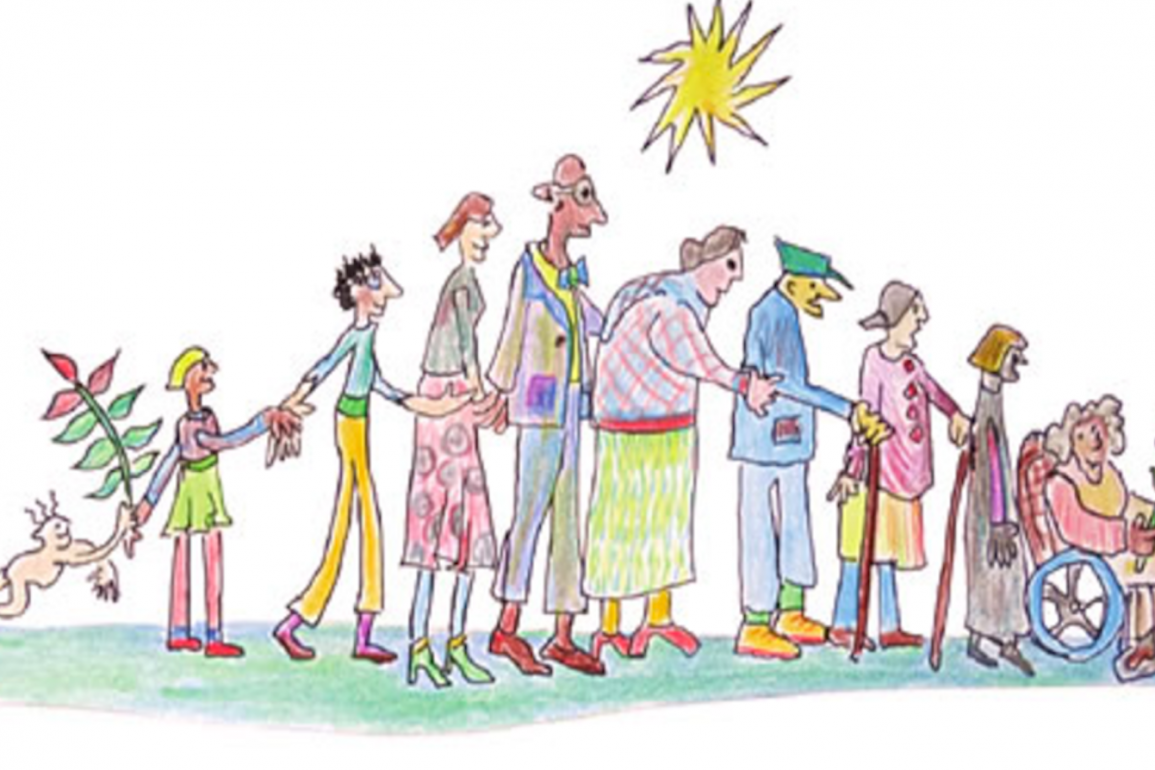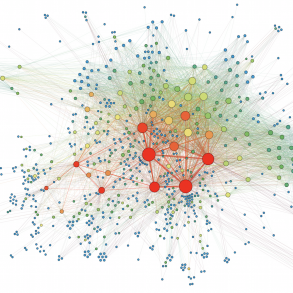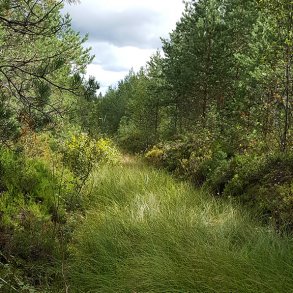A conversation with Dr. Margaret Hannah by Anna Betz for Enlivening Edge Magazine
‘Humanising Healthcare’ – Part 1: Patterns of Hope for a System Under Strain is here.
‘Humanising Healthcare’- Part 2: Doing What Matters and Mobilising around a Purpose is here.
A: So a future National Health Service in the UK in your view won’t be either one thing or another but ‘both-and’. Especially for chronic conditions, there won’t be one uniform way across the UK of providing healthcare. At the moment the space between community and public service is still very much of a vacuum.
What is your sense of what will emerge in that space in between public service and community? People are afraid to lose the NHS and want to hold on to what we’ve got. The fear is also about private medicine taking over which would leave many people without affordable and adequate healthcare.
Do we need to go down the American route of private medicine? Is there another way besides public and private? It may be something for which there isn’t yet a ready-made model but that will emerge from within communities.
M: It will have to be community-led organisations that link to services. Professionals will need to become more facilitators of change and to enable connections where they are missing. They need to link people to community groups and whatever else helps them.
I keep saying it is about the spectrum of providers which ranges from public, private, non-profits to partially-profitable. They might be entirely voluntary like the churches who tend not to charge at all and play a very important part in the fabric of care.
I think again part of the practice is to involve what is happening in your own patch, not to look for one-size-fits-all solutions. This is what the problem with the policy makers is. They are driven by public-or-private mentality.
They don’t locate what they are trying to achieve within the context of a community that has all kinds of links, ties, relationships, and patterns of being, doing, and connecting.
That is our strength and it is the fabric which is almost like the blueprint for what we are going to evolve from for the next step.
When you are talking about hierarchies, the issue is that the NHS simply can’t develop that kind of community-led service. What I am finding with some of the feedback we are getting about local services is “You couldn’t get this anywhere else”. You couldn’t get it in the public sector somewhere else and you certainly couldn’t get it in the private sector because it is located in Fife. Our practitioners know what is available down the road for someone’s health so they can access whether it is helpful for them.
For example, the leisure centre with their active options and their particular activities. Those won’t be available everywhere.
We are building on what local communities are creating and offering, rather than have a blue print.
We say “Grow it from where you are, and be creative, and you know what it takes to stay well. Ask people: ‘What keeps you well?’ They will come out with what they need.” You just have to take that and make it available to people.
A: Where will the funding for all these community activities be coming from? Will patients have to pay for all that? Will it lead to patients taking more responsibility for their wellbeing? Is paying for it part of learning to take more responsibility for health? Since community groups at present don’t operate as a network but often compete with each other for the same pot of money, what will need to change? Should there be government guidelines?
M: Let’s get back to the example I gave you about the physio department. They are a very busy department treating lots of sports injuries, etc., which is fairly straight forward. They then have these patients with complex problems with lots of things going on at the same time. These are the ones they sit down with and have a good conversation with to elicit personal outcomes, and see what they want to be different in their life.
The department now has a multi-disciplinary team which is also a multi-agency team. They share these complex patients with each other in their meetings. There is a psychologist, a pain clinic person, someone from the Parkinson’s society, and others who all have their clearance for sharing confidential information about patients. So, for example, if one person wants to be able to walk his dog, the obvious people to take that on would be the leisure centre. The person from that place will then work with the patient.
What motivated the people in the example I gave wasn’t the money, as there wasn’t money in that. What motivated them was to get this man walking his dog again, as he was a dog trainer. They were able to do something with this poor man, and that is really what motivates people.
To attend an Active Options class, people will have to pay, £2-3 per session which isn’t a lot. For people on low incomes there are provisions. People are willing to do that kind of work, as it all makes sense.
I agree, we do have to think about where the money comes from. I believe solutions will emerge as people grow more familiar with that kind of working. Your real reward will not be making money out of it, but facilitating these amazing stories which are really helpful. As human beings we have to have that in our lives. We need to have a sense that we are giving something to society. It is an important part of being human. It is what motivates the staff in the health service. Creating that connection with people is wonderful.
References:
http://www.sutherlandtrust.org.uk/
http://www.triarchypress.net/widethinking.html
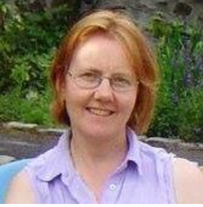 Margaret Hannah is Director of Public Health for NHS Fife, Scotland. She studied medicine at Cambridge University and St Thomas’ Hospital, London and later trained in public health in Hong Kong and London. Margaret has pioneered fresh thinking in public health and the culture of healthcare. She was part of a five-year enquiry into culture and wellbeing which in 2012 culminated in the publication of The Future Public Health (Open University Press). In 2014, she published ‘Humanising Healthcare: Patterns of Hope for a System under Strain (Triarchy Press)’. In addition to her role in Fife, Dr Hannah is a visiting professor at Robert Gordon University and a Fellow of the Royal College of Physicians.
Margaret Hannah is Director of Public Health for NHS Fife, Scotland. She studied medicine at Cambridge University and St Thomas’ Hospital, London and later trained in public health in Hong Kong and London. Margaret has pioneered fresh thinking in public health and the culture of healthcare. She was part of a five-year enquiry into culture and wellbeing which in 2012 culminated in the publication of The Future Public Health (Open University Press). In 2014, she published ‘Humanising Healthcare: Patterns of Hope for a System under Strain (Triarchy Press)’. In addition to her role in Fife, Dr Hannah is a visiting professor at Robert Gordon University and a Fellow of the Royal College of Physicians.
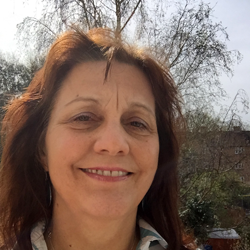 Anna’s background is in Health and Social Care with training in Herbal Medicine, Socialwork, Mindfulness Practice, Transparent Communication, and Systemic Family Therapy. She practices a pro-active evolutionary approach to Health and Wellbeing and leads on projects in the UK National Health Service using Mindfulness and diet for people suffering from chronic inflammatory diseases like diabetes and dementia. Her passion for building thriving and sustainable communities inspired her to co-found the HealthCommonsHub. She feels at home in places where individual, communal, organisational, and social evolution meet, and where people support each other in becoming whole and feel enlivened.
Anna’s background is in Health and Social Care with training in Herbal Medicine, Socialwork, Mindfulness Practice, Transparent Communication, and Systemic Family Therapy. She practices a pro-active evolutionary approach to Health and Wellbeing and leads on projects in the UK National Health Service using Mindfulness and diet for people suffering from chronic inflammatory diseases like diabetes and dementia. Her passion for building thriving and sustainable communities inspired her to co-found the HealthCommonsHub. She feels at home in places where individual, communal, organisational, and social evolution meet, and where people support each other in becoming whole and feel enlivened.
